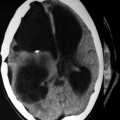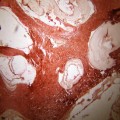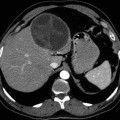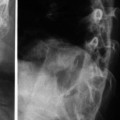Fig. 2.1
The geographical map demonstrating the distribution of the disease according to the strength of endemicity in Mediterranean and Middle East countries
Hydatidosis in Countries of the North Bank of the Mediterranean
Spain
Hydatidosis is still an endemic disease in Spain. The prevalence reached considerable rates up until a few years ago. Although specific control programs initiated in the 1980s have led to marked reductions in CE infection rates, the disease remains an important human and animal health problem in the northeastern, central, and western parts of Spain (Carmena et al. 2008). In the municipality of Madrid, hydatidosis affected 2.88 % of sheep (Rodrigo et al. 1997). In La Roja region, the overall prevalence reached 20.3 % of adult sheep and up to 23 % of sheep and cows (Jiménez et al. 2002).
The Spanish official statistics showed a decrease in the human incidence of CE from 2.52 (in 1982) to 1.01 cases per 100,000 inhabitants (in 1996) (Rojo-Vazquez et al. 2011). In the northeastern, central, and western parts of the country, human incidence rates are in the range of 1.1–3.4 cases per 100,000 inhabitants. However, in Salamanca, the incidence rate reached 10.8 per 100,000 inhabitants in the same period, twice as many as previously reported, suggesting a potential reemergence of the disease (Pardo et al. 2005).
France
The prevalence of hydatidosis from 1994 to 1996 in the Midi-Pyrénées showed a marked decrease in livestock (2.5 %), while local human cases of hydatidosis were less than 0.28 per 100,000 inhabitants (Bichet and Dorchies 1998). From 1966 to 1970, the average annual incidence of human CE was 10 and 4.5 per 100,000 inhabitants in Corsica and in some eastern regions, respectively (Seimenis and Battelli 2003). In addition, AE has been reported in central France, while the Auvergne region represents the most southwestern extension of this disease (Magnaval et al. 2004). Recently, the European Centre for Disease Prevention and Control reported 17 human cases of AE in 2005.
Cerebral occurrence of E. multilocularis disease is rare, accounting for only 1 % of cases. In a survey of 387 patients with AE, Piarroux et al. (2011) have showed that isolated extrahepatic locations of AE account for 4 % of the French cases with spinal and brain involvement in five cases and three cases, respectively (Piarroux et al. 2011).
Italy
Most cases of hydatidosis are recorded in the south of Italy and islands (Fabiani et al. 1980). In fact, the incidence of CE is considered high in Sardinia and Sicily, moderate in the central and southern regions, and low in the remaining areas of Italy (Garippa 2006). With over 1,000 cases requiring surgery each year, Italy is considered as a medium- to high-risk country for human hydatidosis (Dionigi et al. 2007).
The latest surveys on animal epidemiology have shown persistent high regional prevalence in sheep: 76 % in 1995–2000 and 68–75 % during the more recent 2004–2009 survey, ranging from 58 to 83 % in the different provinces, with 10–28 % of sheep harboring fertile cysts (Conchedda et al. 2010).
Human incidence rates in Sardinia was as high as 14.32 per 100,000 inhabitants in the 1940–1950s (Giromini and Granati 1954). Twenty years later, different surveys showed that the human incidence decreased from 14.6 per 100,000 inhabitants in 1969–1973 to 9.8 per 100,000 inhabitants in 1990–1995. During the period 2001–2005, CE still represents a serious health problem in Sardinia. Currently, the mean annual incidence is 6.62 per 100,000 inhabitants (Conchedda et al. 2010).
Former Yugoslavia-Affiliated Countries
CE is known to be endemic in these countries (Seimenis and Battelli 2003; Dakkak 2010). In Bosnia and Herzegovina, the disease is endemic particularly in the region of Herzegovina (Obradović et al. 2006). In Albania, 169 cases of unilocular echinococcosis were recorded in the country in 2010. Approximately 50 % of cases were aged between 16 and 40 years old (Berger 2010). Nevertheless, the AE incidence in Slovenia in 2001–2005 has been estimated at 0.45 per 100,000 inhabitants, with a mean annual incidence of 0.09 cases per 100,000 inhabitants (Logar et al. 2007).
Greece
CE remains a serious problem in Greece for both the public health and the livestock economy. The disease was widely prevalent long before the 1970s. The prevalence of infection in farm animals was as high as 82 % in cattle, 80 % in sheep, 24 % in goats, and 5 % in pigs. The surgical human cases reached 12.9 per 100,000 inhabitants in 1984 (Sotiraki et al. 2003). According to the National Statistical Service of Greece and the Greek Ministry of Health, the incidence of human CE in the period of 1977–1981 was estimated to be 10.9 per 100,000 inhabitants (Sotiraki et al. 2003).
Between 1969 and 1975, Karpathios et al. (1985) carried out a retrospective study to estimate the surgical incidence of hydatidosis among Greeks over 18 years old by collecting records from various communities and private hospitals (Karpathios et al. 1985). According to their findings, 4,202 adult patients were diagnosed with hydatidosis (600 per year) giving an annual incidence of 9.77 per 100,000 inhabitants while 3,397 (80.8 %) underwent surgery (485 patients per year or 7.9 surgical cases per 100,000 inhabitants). Recent data from reported cases indicate a further reduction in incidence. More precisely, the number of human cases reported was 46 (0.45 per 100,000 inhabitants) in 1999 and 0.3 per 100,000 inhabitants in 2008 (Sotiraki and Chaligiannis 2010).
Hydatidosis in Countries of the South Bank of Mediterranean
Morocco
CE is hyperendemic in Morocco, where it is one of the most important zoonoses, and represents a potentially serious public health and economic problem. Epidemiological studies have shown high prevalence rate both in humans and domestic animals, in most agropastoral regions. The first Moroccan series was reported in 1924 by Duckster including 24 cases from Cocard Hospital of Fez (Moroccan Ministry of Health 2007). The repartition of the disease is variable. The Atlas Mountains area is mostly infested compared to the Saharan regions. Indeed, 1.1 % of Berber people in the mid-Atlas mountain region are infested (Macpherson et al. 2004).
In Morocco, the disease is predominant in cow- and sheep-farming regions especially the region of Chaouia-Ouardigha, Meknes-Tafilalet, and Doukkala-Abda (Moroccan Ministry of Health 2007). Recently, Azlaf and Dakak (2006) conducted an epidemiological study aimed to update the prevalence of CE in different animal species living in the most important areas of the country. The global CE infection prevalence rates obtained were 10.58 % in sheep, 1.88 % in goats, 22.98 % in cattle, 12.03 % in camels, and 17.80 % in equines. The infection rates were high in middle Atlas in cattle (48.72 %) and in Northwest in cattle and sheep (37.61 % and 31.65 %, respectively).
In humans, the incidence of CE infection varies between 3.6 and 15.8/100,000 inhabitants (Anderson et al. 1997). Recently, 1,403 surgical human cases were recorded in the country in 2006, representing an annual rate of 4.55 cases per 100,000 inhabitants. Surgeries had to be repeated in 7–10 % and a mortality rate of 2–3 % was observed (Moroccan Ministry of Health 2007). In addition, a human ultrasound screening performed in the middle Atlas Mountains showed much higher prevalence (1 %) than the surgery cases (Kachani et al. 2003).
Concerning CNS hydatidosis, most of the reports consisted of single case reports or small series (Ouboukhlik et al. 1994; Tizniti et al. 2000; El Quessar et al. 2001; Basraoui et al. 2010). These reports state that CNS hydatidosis is rare and constitutes 2 % of all locations (Tizniti et al. 2000). It mostly involves children and young adults (Basraoui et al. 2010; El Abbassi-Skalli et al. 2000) with a mean age of 30 years and male predominance (Ouboukhlik et al. 1994; El Abbassi-Skalli et al. 2000).
Algeria
CE is hyperendemic in Algeria essentially in the northeast of the country and constitutes an important public health problem. Several studies were performed at the beginning of the last century. A retrospective epidemiological study was made in 1979 by Larbaoui and Alloula and showed a clear predominance of cystic hydatidosis in rural areas (74 %). 75.3 % of the affected patients were younger than 40 years old (Larbaoui and Alloula 1979). Each year, more than 700 surgical cases are recorded by the Ministry of Health. Based on hospital records, the reported annual incidence was 3.6–4.6 per 100,000 inhabitants (Shambesh 1997).
Brain hydatidosis is a disease of childhood. This data was confirmed in a series of 99 patients operated for intracranial hydatidosis between 2000 and 2007 in four departments of neurosurgery in Algeria (two in Algiers, one in Annaba, and one in Constantine). 59.5 % of patients were 15 years old or younger (Abdennebi 2009).
Tunisia
CE is hyperendemic in Tunisia and represents a major public health problem due to its high prevalence, morbidity, and economic losses. It is a predominantly rural disease (80.3 % of patients). The annual human incidence of surgical cases of CE is approximately 15 cases per 100,000 inhabitants (Anon 1993). In central Tunisia, 3,986 cases of surgical echinococcosis were identified during 1982–1985, corresponding to an annual rate of 19.3 cases per 100,000 inhabitants (Bchir et al. 1989). Additionally, two autochthonous cases of E. multilocularis infection have been reported in humans from a mountainous region of northern Tunisia (Eckert et al. 2001).
Recently, Bellil et al. (2009) have analyzed the epidemiological features of 265 Tunisian cases of extrapulmonary hydatid cysts collected from 1990 to 2007 in the La Rabta Hospital, Bab Saâdoun, Tunis. They found that hydatidosis involved the CNS in 22.6 % of cases (Bellil et al. 2009). From the same hospital, Limaiem et al. (2010) reviewed retrospectively a series of 39 cases of primary CNS hydatid cysts operated between 1998 and 2007. They found that the disease involved mainly children (33.3 %). The mean age of all patients was 26.5 years old and the male/female ratio was equal. In this series, intracranial hydatid cysts represent 69.2 % (27 cases) and spinal hydatid cysts 30.8 % of cases (12 cases).
Libya
Echinococcosis is highly endemic in Libya. The incidence of surgically confirmed CE in eastern Libya was estimated to be at least 4.2 cases per 100,000 inhabitants, with a clear female predominance (Tashani et al. 2002). In addition, the ultrasound and serology investigations revealed that 1.6 % of population living in the northern Libya had the disease (Shambesh et al. 1999).
Hydatidosis in Western Middle East Countries
Turkey
Turkey is the typical example where echinococcosis is a common parasitic disease causing a serious public health and economic problem (Altinörs et al. 2000). Both CE and AE have been reported. CE is widespread throughout Turkey, whereas AE predominantly occurs in the eastern Anatolian region of the country (Altintas 2003).
According to the Ministry of Health records, 21,303 patients were operated for CE between 1987 and 1994; this corresponds to approximately 2,663 patients per year (Altintas 2003). The estimated surgical case rate ranged from 0.87 to 6.6 per 100,000 inhabitants in Turkey between 1987 and 1994 (Altintas 2003).
A retrospective study based on hospital, regional, and ministerial documents has shown that, from 2001 to 2005, a total of 14,789 CE surgical cases were recorded including 13.13 % that were diagnosed in the Marmara region, 16.94 % in the Aegean region, 16.09 % in the Mediterranean region, 38.57 % in the middle Anatolian region, 5.70 % in the Black Sea region, 6.80 % in the eastern Anatolian region, and 2.75 % in the southeastern Anatolian region (Yazar et al. 2008).
Brain hydatidosis represents 2 % of all space-occupying lesions in Turkish population (Engin et al. 2000). In 2001, Turgut reviewed a series of 276 Turkish cases of intracranial hydatidosis published since 1960. He noticed that most patients with intracranial hydatidosis were males (61 %), from rural areas (Turgut 2001). Cysts were generally located in the cerebral hemispheres and 18 % of patients had other organ infestation (Turgut 2001). He concluded that dimensions, localizations, and numbers of the cysts are the most important prognostic factors (Turgut 2001). The operative mortality rate in this series was 9 % (Turgut 2001). Similarly, Turgut (1997) have reviewed 28 reports of spinal hydatid disease from Turkey published between 1944 and 1996 (Turgut 1997). Turgut (2001) found a clear male predominance (73 %) and that 75 % of patients were aged between 30 and 50 years old. Cysts affecting the spine were commonly observed in the thoracic region and most patients had intraspinal extradural hydatid cysts associated with vertebral involvement (Turgut 2001). He concluded that spinal hydatid disease is still a life-threatening condition in Turkey despite all advances achieved in diagnostic procedures, surgical techniques, and antimicrobial therapeutics (Turgut 2001).
Cyprus
CE was widespread in Cyprus before the 1970s. It was a serious public health problem, with an annual surgical incidence rate of 12.9 per 100,000 inhabitants. In 1971, the first CE eradication campaign was implemented. After 1974, the control program was suspended in the north, while it continued in the southern part of Cyprus until 1985. At that time, the parasite was considered eradicated from both livestock and dogs, and the campaign was officially terminated. However, intermittent outbreaks discovered during slaughterhouse inspections led to reintroduction of the control program in 1993 (Economides and Christofi 2000). Currently, it is considered that echinococcosis transmission has been successfully interrupted in Cyprus as well as Iceland, New Zealand, and Tasmania (Eckert 2001).
Syria and Lebanon
CE is endemic in Syria, mainly in southern and northeastern provinces. Northern Syria, the main area of the country for livestock production, sheep rising, and nomadic tribal life, seems to be the most affected area. In Syria and Lebanon, the prevalence of E. granulosus infection in dogs appears to vary between 9 and 15 % (Seimenis and Battelli 2003), while in livestock, CE prevalence rates are estimated to be between 5 and 17 %, with the highest level in ruminants and donkeys (Seimenis and Battelli 2003).
In Lebanon, Abou-Daoud and Schwabe (1964) reported an incidence of 3.8 cases per 100,000 populations based on surgical records. The annual rate was estimated at 1.38 per 100,000 (1970–1985) (Berger 2010). However, there is no available published data on the current prevalence of human CE in these countries.
Palestine and Israel
Hydatidosis is endemic in Palestine. Abdel-Hafez and Kamhawi (1997) reported that the annual surgical prevalence of CE recorded from the Al-Maqased Hospital in Jerusalem was 1.76 per 100,000 inhabitants in 1995. Abu-Hassan et al. (2002) investigated the surgical incidence of the Palestinian West Bank hospitals between January 1990 and December 1997 (Abu-Hasan et al. 2002); he showed that the annual mean incidence was 3.1 per 100,000 inhabitants, with the highest rates of 4.9, 5.0, and 5.1 per 100,000 inhabitants found in Hebron, Jericho, and Bethlehem, respectively.
Epidemiological studies have reported a high prevalence of CE in both humans and animals in northern Israel (Shimshony 1997). In 2002, Youngster et al. conducted an epidemiological study in northern Israel and found a cumulative infection rate of 1.5 per 100,000 inhabitants, which is comparable to reports of worldwide endemic areas.
Jordan
Human CE is one of the most important endemic infectious diseases in Jordan. The annual rate of human infection was estimated to 2.9 per 100,000 in 1995 (Berger 2010). In serological study, serum samples from 2,388 subjects living in rural-agricultural, semi-Bedouin and Bedouin communities of Jordan showed 7.7 % positivity (Qaqish et al. 2003). Between January 1994 and September 2003, 65 patients from northern Jordan were treated for hydatid cyst in the Department of Surgery, Jordan University hospitals of Irbid. Forty-six percent of patients were below 40 years old and 57 % were females (Yaghan et al. 2004).
CNS hydatidosis is much more common in children than adults. The infant intracranial hydatid disease represents 50–75 % of total infection; the parietal lobe was mostly involved (Khanfar 2004). These data was in accordance with Al-Akayleh who prospectively analyzed five cases of intracranial hydatid cysts managed at the King Hussein Medical Centre, Amman, between 1993 and 2002. Al-Akayleh (2003) found that intracranial hydatidosis represented an incidence of 0.04 % of all space-occupying lesions operated during the studied period. All patients came from rural area and the average age of presentation was 9.4 years old (Al-Akayleh 2003).
Egypt
A survey for hydatidosis among slaughtered animals at two abattoirs in Ismailia and Cairo showed an infection rate of 4.8 % in sheep, 1.2 % in goats, 0.95 % in cattle, 0.46 % in buffalo, and 18.9 % in camels (Sadjjadi 2006). Although human CE is currently of low endemicity, this zoonotic disease may represent a public health concern in Egypt. A retrospective hospital study conducted by Kandeel et al. (2004) showed an annual surgical incidence varying between 1.34 and 2.60 per 100,000 inhabitants (Kandeel et al. 2004).
Hydatidosis in Eastern Middle East Countries
Iran
CE is highly prevalent in Iran, especially in sheep-grazing areas of East Azerbaijan and Kurdistan (Miabi et al. 2005). Cases of human hydatidosis are regularly reported from medical centers in different parts of the nation. Indeed, CE is responsible for approximately 1 % of admission to surgical wards and the rate of human infection is 0.6–1.2 (Rokni 2009). CNS involvement is seen in 2–3 % of patients and affects mainly young adults (Miabi et al. 2005




Stay updated, free articles. Join our Telegram channel

Full access? Get Clinical Tree








